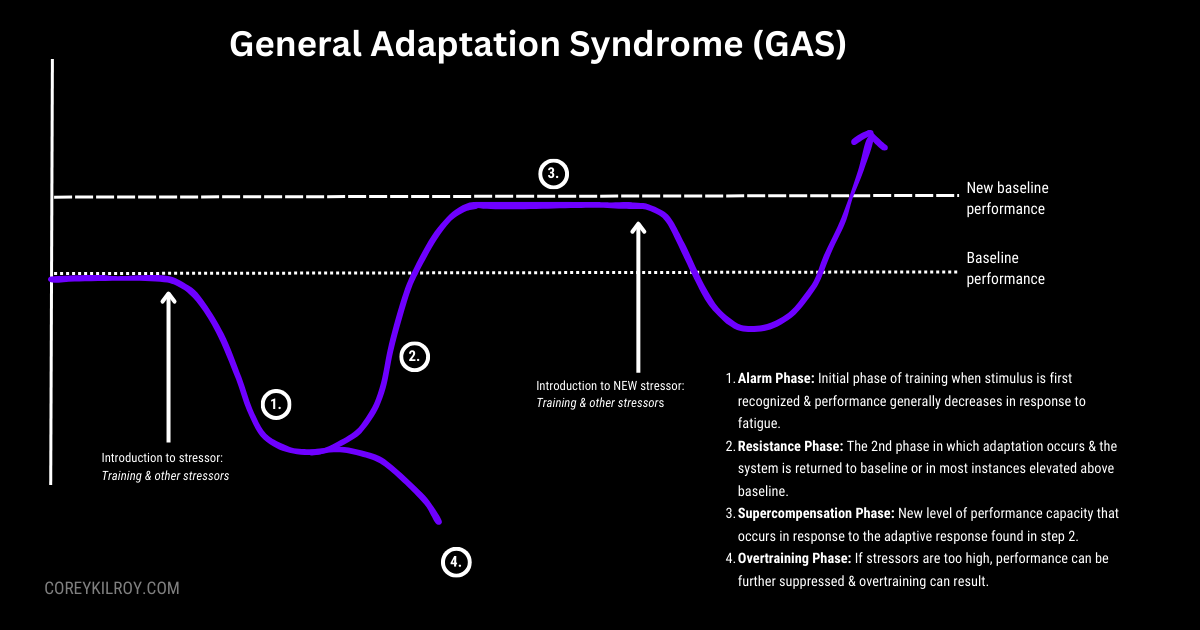Fartlek Running

Since starting my Hybrid Athlete journey, I’ve learned that running isn’t all about long runs.
Yes, distance is an important factor, but endurance training involves so much more.
A training week of running involves easy runs, long runs, and running workouts (like track/speed workouts).
Now, these speed workouts are necessary to increase our overall anaerobic threshold, i.e. our running fitness and endurance.
These higher-intensity workouts allow us to run faster for longer.
This is a basic adaptation principle in exercise physiology and is just as important in running as it is in weight training:

More on the General Adaptation Syndrome (GAS) here.
Additionally, runners are constantly searching for new workouts to add to their training plans.
But sometimes it’s hard running in circles around a track doing 5 x 800m intervals every week.
Running workouts need to be varied in order to push the body to new levels and allow it time for rest and recovery.
Plus, if you run with the same hard effort for every training session, you’ll get burnt out.
Here enters -- Fartlek Runs.
Variety is the secret ingredient for successful high-intensity interval training workouts, and variety is what fartleks are all about.
Fartlek runs are literally, playing around with speeds. Essentially, it's a form of unstructured speedwork.
It involves a continuous run in which periods of faster running are mixed with periods of easy- or moderate-paced running (not complete rest, as with interval training).
You may also use time as the measurement.
It can further be defined as “continuous training with interval training.”
The word “fartlek” is Swedish for “speed play,” highlighting its focus on a variety of fast and slow bursts of running during the duration of the workout.
Fartlek sessions are a challenging workout that pushes athletes outside their comfort zone and combines a mix of warm-up pace, speed work, sprinting, and cool-downs into a constant interval training session designed to increase your heart rate.
Starting to make sense?
All this “speed work” talk, what’s the difference?
When it comes to running workouts, you may also be familiar with tempo runs and interval training.
Fartlek runs are considered in the same category as tempo and interval training, as all three are considered running workouts focused on speed.
Fartlek Runs vs. Tempo Runs vs. Interval Runs - The difference:
As you can see, a fartlek is a continuous run with varying speeds, while interval training sometimes allows you to take a brief rest. Tempo runs involve a warm-up and cool-down with your threshold speed mixed in the middle.
Remember, the goal here is to increase anaerobic fitness levels - being able to run faster for longer.
Nonetheless, all three forms of running workouts may be utilized, one way or another, in a running program to work on endurance levels.
What are the other benefits of Fartlek Running?
- Variety: If you feel like your running has gone stale, you’re not alone. One of the biggest challenges with running is keeping engagement high. You can run the same trail or route over and over again and still lose the excitement you had when first trying the route. Fartlek runs are great because they can be done anywhere (on running trails, on a treadmill, and even on the track). They allow for a change of scenario and are less rigid on exact timing like interval runs.
- Improve speed & endurance: Since Fartleks force your body to be in continuous motion, you can better anticipate mid-race changes to run faster to catch up or pass another racer. The hard effort you expend, depending on your fitness level, in your training workout will be what you can draw from in a race.
- Improved focus: A fartlek session forces you to stay engaged and make active decisions about your running pace. You won’t just maintain a steady pace throughout the entire workout; you’ll be switching it up as you go, making different intervals based on what you’re trying to accomplish.
How can we get started with Fartleks?
You may have already tried Fartleks in your running before.
When running outside, try running faster paces between telephone poles, fire hydrants, trees, etc.
Saying, “I’m gonna run a fast pace until the next telephone pole, slow down between the next one, and repeat”, is exactly what a Fartlek is.
Here’s another example that’s more structured:
- 10 minutes of warm-up pace
- 1-3 minutes of race pace
- 1 minute of resting pace
- Repeat 4-8 times
- 10 minutes of cool-down pace
You can scale the race and resting pace variations depending on how much long-distance running you’re seeking to complete.
In the end…
Fartlek workouts add variety into your training, but you can also change up how you do them to ensure that they never get old.
When it comes to training, creating calculated stress on the body in order to cause physiological adaptations is very important.
Otherwise, zero progress will ever be made.
This carries into running just the same.
Trying Fartlek runs during your speed workouts every once in a while is a great way to add some variety and spice into your training.
Good luck & Keep Pluggin’.
🙇🏻♂️🌱 Until Next Time, C.



